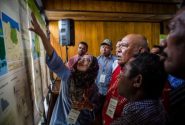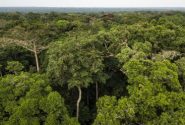
On the road to Brazil. Kate Evans
LIMA, Peru (22 February, 2013)_In the past year, Latin America’s forests saw progress and setbacks that will shape ecosystem health with implications for forest policy in 2013. Here’s a look at issues to watch in the year ahead.
Trends in deforestation
The first half of 2012 brought good news for Brazil’s forests, which account for nearly two-thirds of the Amazon, as the government announced deforestation in 2012 had dropped to its lowest point since the National Space Research Institute began monitoring in the late 1980s.
And Brazil was not alone. A recent report suggests that several other Amazon countries also saw their rates of forest loss drop from 2000 to 2010.
Though a slowing global economy has helped reduce the pace of land-clearing, research featured by the United Nations Environmental Programme and others shows that at least half of the avoided deforestation in the last few years can be attributed to stronger policies.
Land-use change from ranching and farming
It’s too early to claim victory, though, as Brazil’s deforestation rates rose again later in the year, according to the non-profit organization Imazon. Various governments’ goals – such as Brazil’s target of decreasing deforestation by 80 percent from 1990s levels by 2020, or Peru’s pledge of zero net deforestation by 2021 – are challenged by the growth of Amazonian cities, infrastructure development, arrival of new settlers in search for land, and the expansion of ranching and commodity crops such as soy and oil palm.
“It is not justifiable for agribusiness to place additional pressures on forests when there are more suitable lands for agriculture elsewhere and improvements can be made on the ways in which lands are currently managed, such as for cattle raising,” says CIFOR senior scientist Pablo Pacheco.
“Some of these lands are degraded, but they may be restored and be suitable for more intensive uses needed to meet market demands.”
Because international demand for soy and palm oil and other agricultural products is likely to keep increasing, he urges the adoption of improved ways to manage crops expansion so that production does not lead to greater deforestation. Many eyes are on Mato Grosso, the center of soybean expansion in Brazil and Colombia which has led in palm oil production in the region. While impacts on forests conversion have been managed so far, both Brazil and Peru are likely to see significant expansion of palm plantations in the near future.
Understanding the drivers of deforestation is crucial for making good policy and enhancing land and forests governance. A study in Bolivia recommended that of the three main causes of deforestation – mechanized agriculture, small-scale agriculture and cattle ranching – priority should be given to policies targeting ranching.
It is not justifiable for agribusiness to place additional pressures on forests when there are more suitable lands for agriculture elsewhere.
Cattle ranching has also been the main activity placing pressures on forests in Brazil, recent research has shown. Brazil is the world’s largest producer of beef (only India has a higher number of cattle, but most of those are destined to supply milk rather than meat) and cattle ranches account for at least 70% of the cleared forest in the Brazilian Amazon. The practice has been expanding, involving large-scale ranchers as well as smallholders, so promoting more sustainable supply of beef and dairy while avoiding deforestation will be a critical policy issue in the years to come.
Impact of building and paving roads
Urban growth, cattle ranching and agribusiness expansion in Amazonia is also strongly associated with road expansion. But it has been known for some time that the construction of roads and highways across Amazonia is a good predictor of deforestation.
A highway that would cut through Bolivia’s Isiboro Sécure National Park and Indigenous Territory (TIPNIS, for its Spanish initials) sparked protests in 2012 that are likely to continue this year. And a second highway linking Peru and western Brazil, currently on the drawing board, has raised concerns about increased deforestation in that region.
“Highways in the Amazon have a detrimental effect on forests because they provide access to formerly remote areas,” said Amy Duchelle, a post-doctoral research fellow in Center for International Forestry Research’s Forests and Livelihoods Program, who has contributed to the study of the Interoceanic Highway in remote areas along the shared borders of Bolivia, Brazil and Peru.
Those negative effects, however, “can be mitigated through policies designed to manage land use along new roads.”
Compensation for reducing deforestation and degradation
One way to encourage countries to protect their forests is to compensate them for reducing deforestation and forest degradation. So many observers were disappointed that no real progress was made on that incentive – known as REDD+ — at the U.N. climate talks in Doha in December. Questions remain about international guidelines for REDD+ in areas such as monitoring and verification, financing and safeguards.
Despite those international stumbling blocks, however, some countries are moving ahead with local or national REDD+ projects, testing different models for creating conservation incentives.
“Many are already successfully tackling deforestation with the help of REDD+. Much is already being achieved independently of the U.N. Framework Convention on Climate Change and in the absence of an international climate agreement,” Louis Verchot, CIFOR Director of Forest and Environment Research, said after the Doha talks.
Community forest management
Experts also point out that REDD+ is only one incentive. Well-managed timber production, non-timber forest products and environmental services can combine to create a promising strategy for forest conservation and local development, Duchelle says.
In a study focusing on Brazil nut and timber production in Bolivia, Peru and Brazil, she found that although many people take a positive view of such strategies, a number of problems – including theft of Brazil nuts, overlapping land rights, illegal logging of Brazil nut stands and the expansion of cattle ranching – must still be solved.

Smallholders and communities often don’t reap economic benefits from forests due to convoluted and expensive regulations. Richard Vignola
Allowing local communities to manage forests and their resources can be an important step toward conservation, but such schemes face many hurdles. That’s because many may lack clear title to their land, and governments often transfer only partial control over forests to communities, resulting in inefficient co-management, systems that place greater burden and responsibility on local people without ensuring clear benefits according to a study led by Peter Cronkleton, a community forest development specialist with CIFOR.
One positive sign, he said, is that people who have traditionally depended on forest resources – such as indigenous people, Brazil nut harvesters and rubber tappers – are gaining a greater voice in decisions affecting their livelihoods.
But smallholders and communities often don’t reap economic benefits from timber forests recent research has shown, due to regulatory obstacles such as costly permits and imposed timber management systems (species to cut, harvesting cycles, etc.) that are often not adapted to local conditions. This has often forced local actors to move into the informal logging sector.
To ensure good forest management in Latin America, Cronkleton said, countries must clarify “who has the right to participate in decisions about forest resources, how those decisions are made and mechanisms to ensure implementation.”
We want you to share Forests News content, which is licensed under Creative Commons Attribution-NonCommercial-ShareAlike 4.0 International (CC BY-NC-SA 4.0). This means you are free to redistribute our material for non-commercial purposes. All we ask is that you give Forests News appropriate credit and link to the original Forests News content, indicate if changes were made, and distribute your contributions under the same Creative Commons license. You must notify Forests News if you repost, reprint or reuse our materials by contacting forestsnews@cifor-icraf.org.
Further reading
High-yield oil palm expansion spares land at the expense of forests in the Peruvian Amazon
The impacts of selective logging on non-timber forest products of livelihood importance
Soybean and oil palm expansion in South America: A review of main trends and implications
Lowering environmental costs of oil‐palm expansion in Colombia












